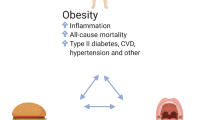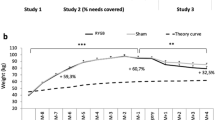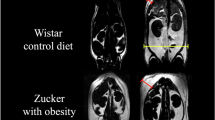Abstract
Pavlovian cues associated with junk-foods (caloric, highly sweet, and/or fatty foods), like the smell of brownies, can elicit craving to eat and increase the amount of food consumed. People who are more susceptible to these motivational effects of food cues may have a higher risk for becoming obese. Further, overconsumption of junk-foods leading to the development of obesity may itself heighten attraction to food cues. Here, we used a model of individual susceptibility to junk-foods diet-induced obesity to determine whether there are pre-existing and/or diet-induced increases in attraction to and motivation for sucrose-paired cues (ie, incentive salience or ‘wanting’). We also assessed diet- vs obesity-associated alterations in mesolimbic function and receptor expression. We found that rats susceptible to diet-induced obesity displayed heightened conditioned approach prior to the development of obesity. In addition, after junk-food diet exposure, those rats that developed obesity also showed increased willingness to gain access to a sucrose cue. Heightened ‘wanting’ was not due to individual differences in the hedonic impact (‘liking’) of sucrose. Neurobiologically, Mu opioid receptor mRNA expression was lower in striatal ‘hot-spots’ that generate eating or hedonic impact only in those rats that became obese. In contrast, prolonged exposure to junk-food resulted in cross-sensitization to amphetamine-induced locomotion and downregulation of striatal D2R mRNA regardless of the development of obesity. Together these data shed light on individual differences in behavioral and neurobiological consequences of exposure to junk-food diets and the potential contribution of incentive sensitization in susceptible individuals to greater food cue-triggered motivation.
Similar content being viewed by others
Log in or create a free account to read this content
Gain free access to this article, as well as selected content from this journal and more on nature.com
or
References
Alsio J, Olszewski PK, Norback AH, Gunnarsson ZE, Levine AS, Pickering C et al (2010). Dopamine D1 receptor gene expression decreases in the nucleus accumbens upon long-term exposure to palatable food and differs depending on diet-induced obesity phenotype in rats. Neuroscience 171: 779–787.
Anselme P, Robinson MJ, Berridge KC (2013). Reward uncertainty enhances incentive salience attribution as sign-tracking. Behav Brain Res 238: 53–61.
Avena NM, Rada P, Hoebel BG (2008). Evidence for sugar addiction: behavioral and neurochemical effects of intermittent, excessive sugar intake. Neurosci Biobehav Rev 32: 20–39.
Baladi MG, Daws LC, France CP (2012). You are what you eat: influence of type and amount of food consumed on central dopamine systems and the behavioral effects of direct- and indirect-acting dopamine receptor agonists. Neuropharmacology 63: 76–86.
Berridge KC (2000). Measuring hedonic impact in animals and infants: microstructure of affective taste reactivity patterns. Neurosci Biobehav Rev 24: 173–198.
Berthoud HR (2012). The neurobiology of food intake in an obesogenic environment. Proc Nutr Soc 71: 478–487.
Burger KS, Stice E (2014). Greater striatopallidal adaptive coding during cue–reward learning and food reward habituation predict future weight gain. Neuroimage 99: 122–128.
Clegg DJ, Benoit SC, Reed JA, Woods SC, Dunn-Meynell A, Levin BE (2005). Reduced anorexic effects of insulin in obesity-prone rats fed a moderate-fat diet. Am J Physiol Regul Integr Comp Physiol 288: R981–R986.
Cottone P, Sabino V, Nagy TR, Coscina DV, Zorrilla EP (2007). Feeding microstructure in diet- induced obesity susceptible versus resistant rats: central effects of urocortin 2. J Physiol 583 (Pt 2): 487–504.
Dagher A (2009). The neurobiology of appetite: hunger as addiction. Int J Obes 33 (Suppl 2): S30–S33.
Davis CA, Levitan RD, Reid C, Carter JC, Kaplan AS, Patte KA et al (2009). Dopamine for "wanting" and opioids for "liking": a comparison of obese adults with and without binge eating. Obesity (Silver Spring) 17: 1220–1225.
Davis JF, Tracy AL, Schurdak JD, Tschop MH, Lipton JW, Clegg DJ et al (2008). Exposure to elevated levels of dietary fat attenuates psychostimulant reward and mesolimbic dopamine turnover in the rat. Behav Neurosci 122: 1257–1263.
de Weijer BA, van de Giessen E, van Amelsvoort TA, Boot E, Braak B, Janssen IM et al (2011). Lower striatal dopamine D2/3 receptor availability in obese compared with non-obese subjects. EJNMMI Res 1: 37.
Demos KE, Heatherton TF, Kelley WM (2012). Individual differences in nucleus accumbens activity to food and sexual images predict weight gain and sexual behavior. J Neurosci 32: 5549–5552.
DiFeliceantonio AG, Mabrouk OS, Kennedy RT, Berridge KC (2012). Enkephalin surges in dorsal neostriatum as a signal to eat. Curr Biol 22: 1918–1924.
Dunn JP, Cowan RL, Volkow ND, Feurer ID, Li R, Williams DB et al (2010). Decreased dopamine type 2 receptor availability after bariatric surgery: preliminary findings. Brain Res 1350: 123–130.
Fedoroff IC, Polivy J, Herman CP (1997). The effect of pre-exposure to food cues on the eating behavior of restrained and unrestrained eaters. Appetite 28: 33–47.
Gearhardt AN, Yokum S, Orr PT, Stice E, Corbin WR, Brownell KD (2011). Neural correlates of food addiction. Arch Gen Psychiatry 68: 808–816.
Geiger BM, Haburcak M, Avena NM, Moyer MC, Hoebel BG, Pothos EN (2009). Deficits of mesolimbic dopamine neurotransmission in rat dietary obesity. Neuroscience 159: 1193–1199.
Ho CY, Berridge KC (2013). An orexin hotspot in ventral pallidum amplifies hedonic 'liking' for sweetness. Neuropsychopharmacology 38: 1655–1664.
Holland PC, Petrovich GD (2005). A neural systems analysis of the potentiation of feeding by conditioned stimuli. Physiol Behav 86: 747–761.
Huys QJ, Tobler PN, Hasler G, Flagel SB (2014). The role of learning-related dopamine signals in addiction vulnerability. Prog Brain Res 211: 31–77.
Johnson PM, Kenny PJ (2010). Dopamine D2 receptors in addiction-like reward dysfunction and compulsive eating in obese rats. Nat Neurosci 13: 635–641.
Kabbaj M, Devine DP, Savage VR, Akil H (2000). Neurobiological correlates of individual differences in novelty-seeking behavior in the rat: differential expression of stress-related molecules. J Neurosci 20: 6983–6988.
Kennedy A, Gettys TW, Watson P, Wallace P, Ganaway E, Pan Q et al (1997). The metabolic significance of leptin in humans: gender-based differences in relationship to adiposity, insulin sensitivity, and energy expenditure. J Clin Endocrinol Metab 82: 1293–1300.
Kenny PJ (2011). Common cellular and molecular mechanisms in obesity and drug addiction. Nat Rev Neurosci 12: 638–651.
Kessler DA (2009) The end of overeating: taking control of the insatiable American appetite. Rodale Books.
Lenard NR, Zheng H, Berthoud HR (2010). Chronic suppression of mu-opioid receptor signaling in the nucleus accumbens attenuates development of diet-induced obesity in rats. Int J Obes 34: 1001–1010.
Levin BE, Dunn-Meynell AA, Balkan B, Keesey RE (1997). Selective breeding for diet-induced obesity and resistance in Sprague-Dawley rats. Am J Physiol 273 (2 Pt 2): R725–R730.
Levin BE, Dunn-Meynell AA, Banks WA (2004). Obesity-prone rats have normal blood-brain barrier transport but defective central leptin signaling before obesity onset. Am J Physiol Regul Integr Comp Physiol 286: R143–R150.
Mansour A, Meador-Woodruff JH, Bunzow JR, Civelli O, Akil H, Watson SJ (1990). Localization of dopamine D2 receptor mRNA and D1 and D2 receptor binding in the rat brain and pituitary: an in situ hybridization-receptor autoradiographic analysis. J Neurosci 10: 2587–2600.
Parylak SL, Koob GF, Zorrilla EP (2011). The dark side of food addiction. Physiol Behav 104: 149–156.
Paxinos G, Watson CJ (2007) The Rat Brain in Stereotaxic Coordinates, 6th edn. Academic Press: MA, USA.
Robinson TE, Berridge KC (2008). Review. The incentive sensitization theory of addiction: some current issues. Philos Trans R Soc Lond B Biol Sci 363: 3137–3146.
Robinson TE, Flagel SB (2009). Dissociating the predictive and incentive motivational properties of reward-related cues through the study of individual differences. Biol Psychiatry 65: 869–873.
Rothemund Y, Preuschhof C, Bohner G, Bauknecht HC, Klingebiel R, Flor H et al (2007). Differential activation of the dorsal striatum by high-calorie visual food stimuli in obese individuals. NeuroImage 37: 410–421.
Shin AC, Pistell PJ, Phifer CB, Berthoud HR (2010). Reversible suppression of food reward behavior by chronic mu-opioid receptor antagonism in the nucleus accumbens. Neuroscience 170: 580–588.
Shin AC, Townsend RL, Patterson LM, Berthoud HR (2011). "Liking" and "wanting" of sweet and oily food stimuli as affected by high-fat diet-induced obesity, weight loss, leptin, and genetic predisposition. Am J Physiol Regul Integr Comp Physiol 301: R1267–R1280.
Soussignan R, Schaal B, Boulanger V, Gaillet M, Jiang T (2012). Orofacial reactivity to the sight and smell of food stimuli. Evidence for anticipatory liking related to food reward cues in overweight children. Appetite 58: 508–516.
Steele KE, Prokopowicz GP, Schweitzer MA, Magunsuon TH, Lidor AO, Kuwabawa H et al (2010). Alterations of central dopamine receptors before and after gastric bypass surgery. Obes Surg 20: 369–374.
Stice E, Figlewicz DP, Gosnell BA, Levine AS, Pratt WE (2012). The contribution of brain reward circuits to the obesity epidemic. Neurosci Biobehav Rev 37 (9 Pt A): 2047–2058.
Stice E, Yokum S, Bohon C, Marti N, Smolen A (2010). Reward circuitry responsivity to food predicts future increases in body mass: moderating effects of DRD2 and DRD4. NeuroImage 50: 1618–1625.
Stoeckel LE, Weller RE, Cook EW 3rd, Twieg DB, Knowlton RC, Cox JE (2008). Widespread reward-system activation in obese women in response to pictures of high-calorie foods. NeuroImage 41: 636–647.
Tetley A, Brunstrom J, Griffiths P (2009). Individual differences in food-cue reactivity. The role of BMI and everyday portion-size selections. Appetite 52: 614–620.
Thompson RC, Mansour A, Akil H, Watson SJ (1993). Cloning and pharmacological characterization of a rat mu opioid receptor. Neuron 11: 903–913.
Vezina P, Leyton M (2009). Conditioned cues and the expression of stimulant sensitization in animals and humans. Neuropharmacology 56 (Suppl 1): 160–168.
Volkow ND, Wang GJ, Tomasi D, Baler RD (2013a). The addictive dimensionality of obesity. Biol Psychiatry 73: 811–818.
Volkow ND, Wang GJ, Tomasi D, Baler RD (2013b). Obesity and addiction: neurobiological overlaps. Obes Rev 14: 2–18.
Acknowledgements
We thank Dr Terry E Robinson for use of locomotor testing chambers, Dr Mark EJ Newman for writing the diet composition program, Dr Jason Whalen for Mulitplex analysis, Hong Keun Yoon, Kate Dykhuis, and Jim Stewart for technical assistance, and Dr Peggy E Gnegy and Dr Paul J Meyer for helpful conversations. This work was funded by MH63649 and DA015188 to KCB awarded by NIMH and NIDA, and DK092322 to PRB awarded by NIDDK and utilized the Chemistry Core of the Michigan Diabetes Research and Training Center funded by DK020572 awarded by NIDDK. Dr Mike Robinson is currently an Assistant Professor of Psychology and Neuroscience & Behavior at Wesleyan University, Middletown, CT 06459.
Author information
Authors and Affiliations
Corresponding author
Additional information
Supplementary Information accompanies the paper on the Neuropsychopharmacology website
Rights and permissions
About this article
Cite this article
Robinson, M., Burghardt, P., Patterson, C. et al. Individual Differences in Cue-Induced Motivation and Striatal Systems in Rats Susceptible to Diet-Induced Obesity. Neuropsychopharmacol 40, 2113–2123 (2015). https://doi.org/10.1038/npp.2015.71
Received:
Revised:
Accepted:
Published:
Issue date:
DOI: https://doi.org/10.1038/npp.2015.71
This article is cited by
-
Food addiction and its relationship with other eating behaviours among Spanish university students
Journal of Eating Disorders (2023)
-
Cocaine-induced plasticity, motivation, and cue responsivity do not differ in obesity-prone vs obesity-resistant rats; implications for food addiction
Psychopharmacology (2023)
-
Comparison of visceral fat lipolysis adaptation to high-intensity interval training in obesity-prone and obesity-resistant rats
Diabetology & Metabolic Syndrome (2022)
-
Neuroimaging and modulation in obesity and diabetes research: 10th anniversary meeting
International Journal of Obesity (2022)
-
Sex specific effects of “junk-food” diet on calcium permeable AMPA receptors and silent synapses in the nucleus accumbens core
Neuropsychopharmacology (2021)



